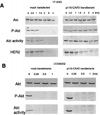Ansamycin antibiotics inhibit Akt activation and cyclin D expression in breast cancer cells that overexpress HER2
- PMID: 11850835
- PMCID: PMC3221005
- DOI: 10.1038/sj.onc.1205184
Ansamycin antibiotics inhibit Akt activation and cyclin D expression in breast cancer cells that overexpress HER2
Abstract
Ansamycin antibiotics, such as 17-allylaminogeldanamycin (17-AAG), bind to Hsp90 and regulate its function, resulting in the proteasomal degradation of a subset of signaling proteins that require Hsp90 for conformational maturation. HER2 is a very sensitive target of these drugs. Ansamycins cause RB-dependent G1 arrest that is associated with loss of D-cyclins via a PI3 kinase, Akt dependent pathway. Downregulation of D-cyclin was due, in part, to loss of Akt expression in response to drug. Moreover, in HER2 overexpressing breast cancer cells, 17-AAG caused rapid inhibition of Akt activity prior to any change in Akt protein. Ansamycins caused rapid degradation of HER2 and a concomitant loss in HER3 associated PI3 kinase activity. This led to a loss of Akt activity, dephosphorylation of Akt substrates, and loss of D-cyclin expression. Introduction into cells of a constitutively membrane bound form of PI3 kinase prevented the effects of the drug on Akt activity and D-cyclins. Thus, in breast cancer cells with high HER2, Akt activation by HER2/HER3 heterodimers is required for D-cyclin expression. In murine xenograft models, non-toxic doses of 17-AAG markedly reduced the expression of HER2 and phosphorylation of Akt and inhibited tumor growth. Thus, pharmacological inhibition of Akt activation is achievable with ansamycins and may be useful for the treatment of HER2 driven tumors.
Figures





References
-
- Alessi DR, James SR, Downes CP, Holmes AB, Gaffney PR, Reese CB, Cohen P. Curr. Biol. 1997;7:261–269. - PubMed
-
- Bardelli A, Basile ML, Audero E, Giordano S, Wennstrom S, Menard S, Comoglio PM, Ponzetto C. Oncogene. 1999;18:1139–1146. - PubMed
-
- Baselga J, Tripathy D, Mendelsohn J, Baughman S, Benz CC, Dantis L, Sklarin NT, Seidman AD, Hudis CA, Moore J, Rosen PP, Twaddell T, Henderson IC, Norton L. J Clin Oncol. 1996;14:737–744. - PubMed
-
- Czar MJ, Galigniana MD, Silverstein AM, Pratt WB. Biochemistry. 1997;36:7776–7785. - PubMed
Publication types
MeSH terms
Substances
Grants and funding
LinkOut - more resources
Full Text Sources
Other Literature Sources
Medical
Research Materials
Miscellaneous

